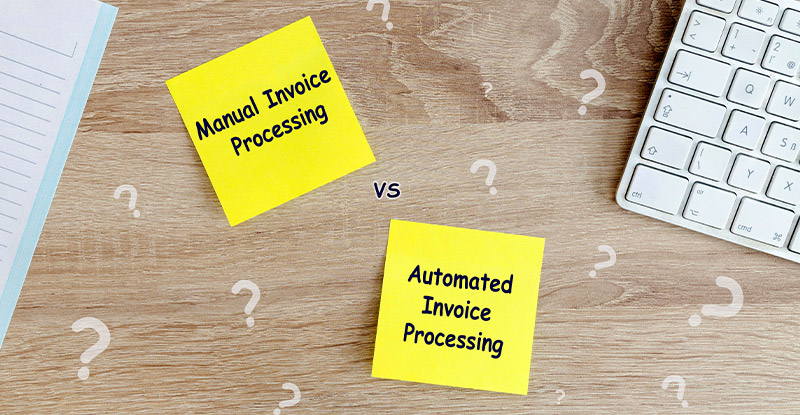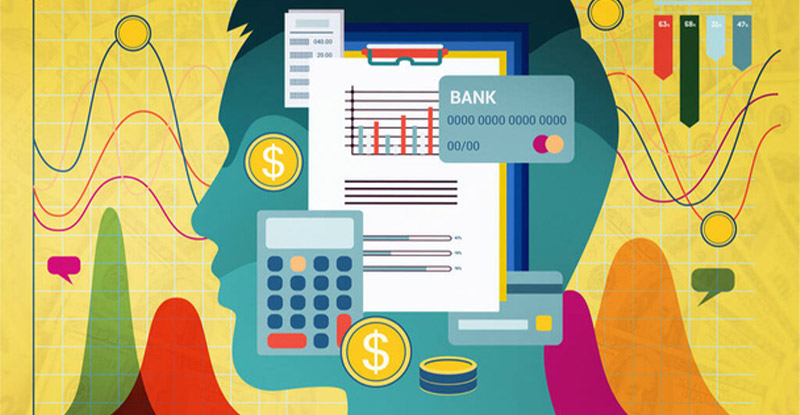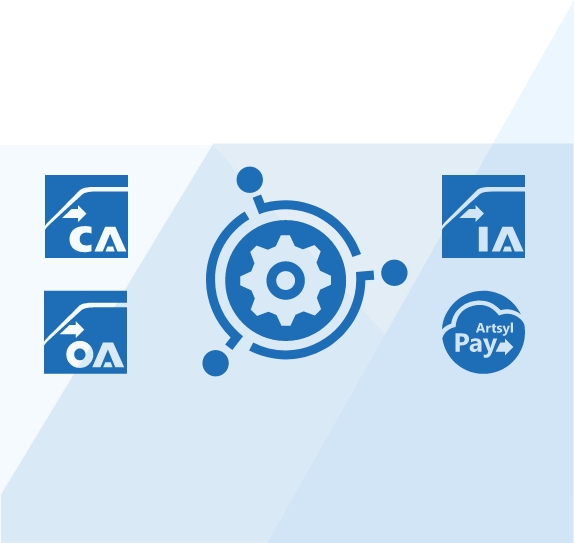Key Takeaways
In the dynamic world of business, the efficiency of financial operations is crucial for a company’s success. One vital component of financial management is invoice processing. Traditionally, manual invoice processing was the standard procedure, but technological advances have given rise to automated invoice processing solutions. In this blog, we’ll delve into the differences between manual and automated invoice processing, examining their benefits and disadvantages, sharing relevant statistics, discussing industries that gain the most from automation, methods to automate invoice processing, and how extracted data seamlessly integrates with Enterprise Resource Planning (ERP) systems.
Experience the seamless transition from manual to automated invoice processing with InvoiceAction. Unlock efficiency, reduce errors, and optimize your financial workflow. Schedule a demo today!
Book a demo now
The Battle Begins — Manual Invoice Processing Challenge
In the world of managing finances, manual invoice processing is a common method where people handle, sort, and enter invoice data. This traditional way has its good sides, but it also has some problems we need to talk about.
So, how does manual invoice processing work? Well, the employees in the accounts payable department are responsible for this job. They carefully handle incoming invoices, put them into the right categories, and manually enter the important information. This hands-on approach has an advantage — it allows people to double-check each invoice for mistakes, problems, or anything suspicious.
But, here’s the downside: as the number of invoices grows, the time it takes to process them also increases. Manual processing is slow, and that can lead to late payments, late fees, and missed chances to get early payment discounts. Plus, even with careful people, there’s always a risk of mistakes. This means errors, lost documents, and problems with efficiency are common.
There’s another issue — manual processing doesn’t provide a clear view of what’s going on. Since everything is done on paper, it’s hard to keep track of invoices and make good financial decisions.
Invoice Automation Software
Related Videos
Benefits of Manual Invoice Processing
Human Oversight: Manual processing allows for human oversight, which can be crucial in identifying errors, inconsistencies, or irregularities in invoices.
Adaptability: Manual processes are more adaptable to handle exceptions and unique invoice formats that automated systems may struggle with.
No Upfront Costs: There are no significant upfront costs involved in implementing manual invoice processing, making it accessible to smaller businesses.
Disadvantages of Manual Invoice Processing:
Time-Consuming: Manual processing is incredibly time-consuming, leading to delayed payments, late fees, and missed opportunities for early payment discounts.
Error-Prone: Human error is a constant risk in manual processing, leading to inaccuracies, misplacement of documents, and inefficiencies.
Lack of Visibility: Tracking and managing invoices becomes challenging without digital records, causing a lack of visibility into the accounts payable process.
Transform your invoicing efficiency with InvoiceAction’s seamless transition from manual to automated processing. Experience a seamless financial workflow without the hassles of errors. Ready to experience
the future of invoicing?
Book a demo now
Automation Takes the Stage — Automated Invoice Processing
Automated invoice processing relies on software and technologies to streamline the entire invoicing process, from receipt to payment approval. Here, we enter the realm of automation and its many benefits.
Benefits of Automated Invoice Processing:
Speed and Efficiency: Automation significantly reduces the time needed to process invoices, leading to faster payments and improved cash flow management.
Accuracy: Automated systems minimize the risk of human errors, ensuring that invoices are processed accurately and consistently.
Cost Savings: Over time, automated processing reduces costs associated with manual labor, paper, printing, and storage.
Enhanced Visibility: Automation provides real-time insights into the status of invoices, making it easier to monitor and manage accounts payable.
Compliance and Security: Automated systems can enforce compliance with company policies and enhance data security, reducing the risk of fraud.
Disadvantages of Automated Invoice Processing:
Despite the initial costs associated with implementing automated systems for invoice processing—including software, hardware, and training expenses—the overall investment proves to be the right path. The long-term benefits far outweigh the initial financial commitment. Automation saves on labor costs, enhances accuracy, accelerates processing times, and significantly reduces the risk of errors, such as avoiding double payments. In the grand scheme, the advantages of automated invoice processing contribute to substantial savings and increased operational efficiency.
Statistics: Manual vs. Automated Invoice Processing
Let’s explore some key statistics to understand the impact of both manual and automated invoice processing methods:
According to the Institute of Finance & Management (IOFM), manual processing can cost up to $16 per invoice, whereas automation reduces the cost to as low as $3 per invoice.
The Ardent Partners’ 2021 State of ePayables report revealed that 53% of organizations are using manual methods for invoice processing, while 47% have invested in automation to some extent.
The same report indicates that automated processing can cut the time it takes to process invoices by up to 80%, significantly improving efficiency.
Revolutionize your workflow! Embrace efficiency and accuracy – automate all your invoice processing steps with InvoiceAction. Elevate your financial processes today!
Book a demo now
At what volume of invoices per month/year does it become practical for an organization to transition from manual to automated invoice processing?
The decision to switch from manual invoice processing to automated invoice processing depends on various factors, and the specific quantity of invoices an organization needs to process per month or year may vary based on its unique circumstances. There is no one-size-fits-all answer, but here are some key considerations that can help determine when it makes sense to switch to automation:
- Cost Savings: Evaluate the cost of manual processing versus the cost of implementing an automated system. Consider factors such as labor costs, error correction expenses, late payment penalties, and the cost of lost discounts. If the potential cost savings from automation outweigh the initial investment and ongoing operating costs, it may be a good time to switch.
- Efficiency Gains: Assess how much time and effort is currently being spent on manual processing. If manual processing is causing delays, leading to late payments, or overwhelming your team, it might be time to automate to improve efficiency.
- Invoice Volume: While there’s no strict threshold, higher invoice volumes often make automation more appealing. Smaller organizations might find it cost-effective to automate with a relatively lower invoice volume, while larger organizations may only consider it when dealing with a substantial number of invoices each month.
- Error Rates: Consider the rate of errors and discrepancies in your manual processing. If errors are common and result in financial losses or reconciliation problems, automation can significantly reduce error rates.
- Scalability: Think about your organization’s growth prospects. If you anticipate an increase in invoice volume as your business expands, automation can help you handle the growth more effectively.
- Resource Availability: Assess your organization’s IT capabilities and the availability of resources for implementing an automated system. Ensure you have the necessary support and infrastructure for a smooth transition.
- Supplier and Customer Expectations: Consider the expectations of your suppliers and customers. If they prefer or require electronic invoicing, automation becomes a necessity.
- Regulatory Compliance: In some industries, regulatory compliance requirements may necessitate electronic invoice processing. Ensure that you meet these requirements.
- Competitive Advantage: Evaluate how automation might provide a competitive advantage in terms of quicker response times, improved accuracy, and better financial management.
- Return on Investment (ROI): Calculate the potential ROI from automation by factoring in cost savings, efficiency gains, and improved accuracy. A positive ROI is a strong indicator that automation is justified.

Unlock remarkable savings by automating thousands of invoices!
Experience an incredible ROI with InvoiceAction for AP automation. Rely on efficiency, accuracy, and seamless processing. Elevate your accounts payable – choose InvoiceAction today!
If we are discussing the approximate number of invoices that a company should process per month to make adopting invoice automation viable, we must take various factors into account, including the organization’s size, industry, available resources, and financial objectives. Nevertheless, as a general rule of thumb, many organizations start contemplating invoice automation when they consistently handle a monthly volume of approximately 400 invoices or more. Here are some considerations based on invoice volume:
- Low Volume (Less than 100 Invoices per Month):
- Smaller businesses with limited resources might start considering automation when they have around 100 or more invoices per month.
- The decision to automate at this level may be influenced by a focus on efficiency and reducing manual data entry.
- Medium Volume (100 to 500 Invoices per Month):
- Many mid-sized companies with this volume of invoices often find it cost-effective to implement automation to streamline their accounts payable processes.
- Efficiency gains and cost savings can be significant in this range, making automation attractive.
- High Volume (500 or More Invoices per Month):
- Larger organizations and enterprises typically have a monthly invoice volume of 500 or more.
- For such companies, automation becomes almost a necessity to handle the substantial volume efficiently, reduce errors, and gain better financial control.
It’s important to note that the decision to implement invoice automation is not solely based on the quantity of invoices. Other factors such as cost savings, accuracy, scalability, competitive pressures, regulatory compliance, and the desire for improved financial management also play a crucial role.
Ultimately, the best approach is to conduct a comprehensive cost-benefit analysis, taking into account your organization’s specific needs, goals, and resources. Evaluate the potential return on investment (ROI) and assess how automation can impact efficiency, reduce error rates, and improve financial processes. If the benefits of automation, such as reduced costs, improved accuracy, and better cash flow management, outweigh the initial investment, it’s a strong indicator that it’s the right time to start using invoice automation, even if your invoice volume is lower than the guidelines mentioned above.
Industries that Benefit from Automation
While automation can benefit various industries, some sectors are more likely to reap substantial advantages from automated invoice processing, including:
Retail: E-commerce enterprises and traditional brick-and-mortar stores alike can efficiently manage high volumes of invoices through automated processing, realizing significant benefits over manual handling. In the retail sector specifically, automated invoice processing not only enhances operational efficiency but also contributes to seamless inventory management and precise financial record-keeping.
Manufacturing: In the manufacturing industry, implementing invoice automation brings transformative benefits to the accounts payable invoice processing landscape. Streamlining the traditionally intricate process of invoice management, automation accelerates the approval and payment cycles, leading to enhanced efficiency. By reducing manual intervention, the risk of errors diminishes, ensuring accurate financial records. The automation of accounts payable invoice processing allows manufacturers to gain real-time insights into their financial operations, facilitating better decision-making. Furthermore, as the manufacturing sector often handles a high volume of invoices, automation mitigates the burden of manual data entry, enabling the workforce to focus on more strategic tasks. In this context, invoice automation holds the potential to redefine the meaning of invoices for the manufacturing industry, shifting them from being mere transactional documents to strategic tools that optimize operational workflows and financial management.
Tailor your success story with InvoiceAction’s versatile invoice automation solutions. From distribution to manufacturing, unlock efficiency and accuracy across diverse industries. Revolutionize your invoicing processes – discover the perfect automation for your industry with InvoiceAction!
Book a demo now
Distribution: In the distribution sector, where the volume of invoices is often substantial, the advantages of invoice automation become even more pronounced in comparison to manual processing. Automation excels in expediting approval and payment cycles, ensuring faster processing and superior cash flow management. By significantly reducing errors, it enhances accuracy in financial records, offering real-time visibility into accounts payable processes. The efficiency gained from automation is particularly crucial for distributors dealing with a high volume of invoices, allowing them to redirect resources to more strategic tasks. Moreover, automation facilitates seamless compliance with payment terms, mitigating the risk of late payments and associated penalties. This underscores how, for distributors dealing with a massive influx of invoices, the transition to invoice automation signifies a strategic move towards enhanced efficiency, accuracy, and improved financial control.
Healthcare: Healthcare facilities, in their multifaceted operations, grapple with a myriad of invoices related to supplies, equipment, and services. The sheer volume and diversity of financial transactions in the healthcare sector make the utilization of invoice automation not just beneficial but imperative. By streamlining the accounts payable processes, automation brings unparalleled efficiency and accuracy to the handling of invoices, a critical aspect for healthcare institutions aiming to maintain seamless operations.
Wholesale: For wholesale companies, automated invoice processing is generally superior to manual methods. It boosts efficiency, accelerates processing times, reduces errors, and offers real-time visibility into financial transactions. The scalability of automation is particularly beneficial for handling the high volume of invoices typical in wholesale operations, allowing for more strategic resource allocation. Overall, automated processing enhances the effectiveness and accuracy of financial operations for wholesale companies.
Business Process Outsourcing: The BPO companies, specializing in processing various documents, including invoices, garner substantial benefits through automated invoice processing compared to manual alternatives. Given that these firms derive revenue from providing finance and accounting outsourcing services, the speed and precision offered by automated solutions are pivotal for their operations. Relying on manual invoice processing is impractical for BPO companies due to the potential for errors and inefficiencies associated with manual data entry. By adopting solutions like InvoiceAction, software designed for automated invoice processing, BPO companies significantly enhance the efficiency and accuracy of their entire invoice processing workflow. Through the use of InvoiceAction software, BPO companies streamline crucial tasks such as data entry, validation, approval, invoice capture, validation against purchase orders, routing, and seamless integration with accounting systems.
Methods to Automate Invoice Processing
The transition from manual to automated invoice processing requires careful planning and the right tools. Here are some methods to automate the process:
Invoice Capture Software: It plays a pivotal role in transitioning organizations from manual to automated invoice processing. This technology streamlines the cumbersome process of manual data entry by automating the extraction of key information from invoices. As companies adopt Invoice Capture Software, they experience enhanced efficiency, reduced error rates, and accelerated processing times. This transition empowers organizations to redirect resources to more strategic tasks, fostering productivity and cost savings. InvoiceAction software, for instance, offers a robust solution for automating invoice processing, allowing companies to effortlessly capture, validate, and integrate invoice data into their systems, ultimately optimizing their financial workflows.
No more manual work! Upgrade your invoicing process today with InvoiceAction’s Invoice Capture software. Optimize efficiency, reduce errors, and transform your invoicing workflow. Experience the future of automated invoice processing – choose InvoiceAction now!
Book a demo now
Invoice Approval Workflow Automation: Embracing Invoice Approval Workflow Automation revolutionizes how organizations handle the approval process, marking a significant shift from manual methods to streamlined automation. This technology expedites approval cycles, reduces delays, and enhances overall workflow efficiency. Transitioning to Invoice Approval Workflow Automation ensures a more transparent and auditable process, minimizing the risk of errors and ensuring compliance with organizational policies. Companies leveraging Invoice Workflow Automation, as provided by InvoiceAction, enjoy advantages including enhanced accuracy, expedited decision-making, and heightened visibility into the approval pipeline. The InvoiceAction software seamlessly facilitates this transition, presenting a robust platform for organizations to automate and optimize their invoice approval workflows.
Integration with ERP Systems: Having integration with ERP systems like SAP, Oracle, MS Dynamics, Sage, Acumatica, or QuickBooks ensures that the invoice automation software facilitates the seamless flow of extracted data into the accounting software.
Cloud-Based Solutions: Cloud-based solutions play a pivotal role in invoice automation by providing a flexible and accessible platform for businesses. These solutions enable real-time collaboration and data accessibility from anywhere, fostering seamless communication among team members involved in the invoicing process. With the ability to store and process large volumes of data in the cloud, businesses can streamline their invoice workflows, ensuring quicker processing times and enhanced accuracy. Additionally, cloud-based invoice automation solutions often come with built-in security features, ensuring the confidentiality and integrity of sensitive financial information. Overall, leveraging cloud technology in invoice automation offers businesses the agility, scalability, and efficiency needed to adapt to evolving invoicing demands in today’s dynamic business landscape.
Supplier Portals: Supplier portals serve as a valuable method for automating invoice processing, offering a centralized platform where businesses and their suppliers can collaborate on invoicing activities. By utilizing supplier portals, organizations can streamline the submission, validation, and approval of invoices. This method fosters improved communication and transparency between buyers and suppliers, reducing the likelihood of errors and delays in the invoicing process. Additionally, supplier portals often integrate with accounting and Enterprise Resource Planning (ERP) systems, ensuring a smooth and automated flow of data from the portal to these essential business platforms. Overall, supplier portals present an effective solution for automating and optimizing the entire invoice processing workflow.
Integrating Extracted Data with ERP Systems
The final piece of the puzzle is ensuring that the data extracted from invoices makes its way into your ERP system. This integration is crucial for maintaining accurate and up-to-date financial records.
Data Mapping: Establish a mapping system that aligns the extracted data fields with the corresponding fields in your ERP system.
Automation Rules: Set up rules that automate the transfer of data into your ERP, ensuring that it is correctly categorized and processed.
Validation and Verification: Implement checks and validation steps to ensure that the extracted data matches the required format and is error-free.
Real-Time Integration: For the best results, aim for real-time integration so that your financial data is always current and accurate.
Unlock the full potential of your invoicing process! From verification and validation to 3-way matching, automated rules, GL coding, and beyond—experience comprehensive automation with InvoiceAction.
Book a demo now
Conclusion
The debate between manual and automated invoice processing continues, but it’s clear that automation offers significant advantages in terms of efficiency, accuracy, and cost savings. While the transition to automation may require upfront investment and technological adaptation, it is a game-changer for businesses looking to optimize their financial operations. As industries continue to evolve and technological solutions become more advanced, the adoption of automated invoice processing is expected to grow, ultimately redefining the landscape of financial management for the better.
Key Terms Explained
What is AP automation?
Accounts Payable (AP) automation refers to the use of technology and software solutions to streamline and optimize the processes involved in managing and paying supplier invoices. This automation typically includes tasks such as invoice capture, data entry, validation, approval workflows, and integration with accounting systems. The goal of AP automation is to enhance efficiency, reduce errors, and provide real-time visibility into financial transactions, ultimately improving the overall accounts payable workflow within an organization.
What is Validation and Verification in Invoice Automation?
Verification and validation are integral to the success of invoice automation, as they contribute to accuracy, compliance, and the overall efficiency of the invoicing process. These processes help organizations minimize errors, reduce manual intervention, and enhance the reliability of automated systems in handling invoices. Here’s how they are typically applied:
Verification in Invoice Automation:
Process: Verification in invoice automation involves confirming that the data and information within the automated system align with the predefined rules, standards, and specifications.
Example: Verifying the accuracy of extracted data from invoices against predefined rules and data formats to ensure it meets the required standards.
Validation in Invoice Automation:
Process: Validation in invoice automation ensures that the automated system and processed invoices meet the intended business needs and requirements.
Example: Validating the automated approval workflows to ensure they align with the organization’s invoicing policies and procedures, and testing the system in a real-world environment to confirm it functions as expected.
What are Automation Rules in Invoice Automation?
Automation rules in invoice automation refer to predefined instructions or criteria set within the automation software to govern how the system should process and handle invoices. These rules are established to automate specific tasks and decisions, reducing the need for manual intervention. The functionality of invoice automation rules includes:
Data Extraction: Automation rules can define how data should be extracted from incoming invoices, specifying fields like invoice number, date, amount, and other relevant information.
Validation: Rules can validate extracted data against predefined criteria to ensure accuracy and compliance with established standards.
Approval Workflow: Automation rules may determine the approval workflow based on factors such as invoice amount, vendor, or department, automating the routing of invoices through the approval process.
Exception Handling: Rules can address exceptions or discrepancies, triggering specific actions or notifications for manual review when needed.
What is Data Mapping in Invoice Processing?
Data mapping in invoice processing refers to the process of linking and matching data fields from invoices to corresponding fields in an organization’s database or enterprise system. It involves creating a relationship between the data extracted from invoices and the specific data fields within an organization’s internal systems.
Let’s break down the key aspects of data mapping in invoice processing:
Extraction of Data: During the invoice processing workflow, relevant information such as invoice number, date, line items, and amounts is extracted.
Identification of Data Fields: Data mapping involves identifying the corresponding fields in the organization’s database or enterprise resource planning (ERP) system where the extracted data needs to be stored.
Establishing Relationships: Data mapping establishes the relationships between the extracted data and the specific fields in the internal system. This ensures that the right information is accurately transferred and stored in the appropriate locations.
Automation: In automated invoice processing systems, data mapping is often a crucial step that enables the seamless flow of information from invoices to internal databases. Automated systems use predefined data mapping rules to ensure consistency and accuracy in the data transfer process.
Integration with ERP Systems: Data mapping is particularly relevant when integrating invoice processing solutions with ERP systems. It ensures that the data captured from invoices aligns with the structure and requirements of the organization’s broader business systems.
In essence, data mapping streamlines the transfer of information between invoices and internal systems, reducing manual efforts, minimizing errors, and facilitating a more efficient and accurate invoice processing workflow.
What is ERP?
ERP stands for Enterprise Resource Planning. It is a type of software that organizations use to manage and integrate various aspects of their business processes. ERP systems provide a centralized platform that enables seamless communication and collaboration across different departments, such as finance, human resources, supply chain, and customer service. These systems help organizations streamline operations, improve efficiency, and make data-driven decisions by providing a comprehensive view of business activities and processes. ERP software often includes modules for functions like accounting, inventory management, procurement, project management, and more.


 Invoice Reconciliation: The Ultimate Guide
Invoice Reconciliation: The Ultimate Guide Automated Invoice Matching with AI
Automated Invoice Matching with AI Automated Invoice Processing: Balancing Automation and Human Oversight
Automated Invoice Processing: Balancing Automation and Human Oversight 7 Powerful Benefits of Invoice Automation for Controllers and CFO
7 Powerful Benefits of Invoice Automation for Controllers and CFO Invoice Management Guide
Invoice Management Guide How to Build an Automated Invoice Processing Workflow
How to Build an Automated Invoice Processing Workflow

